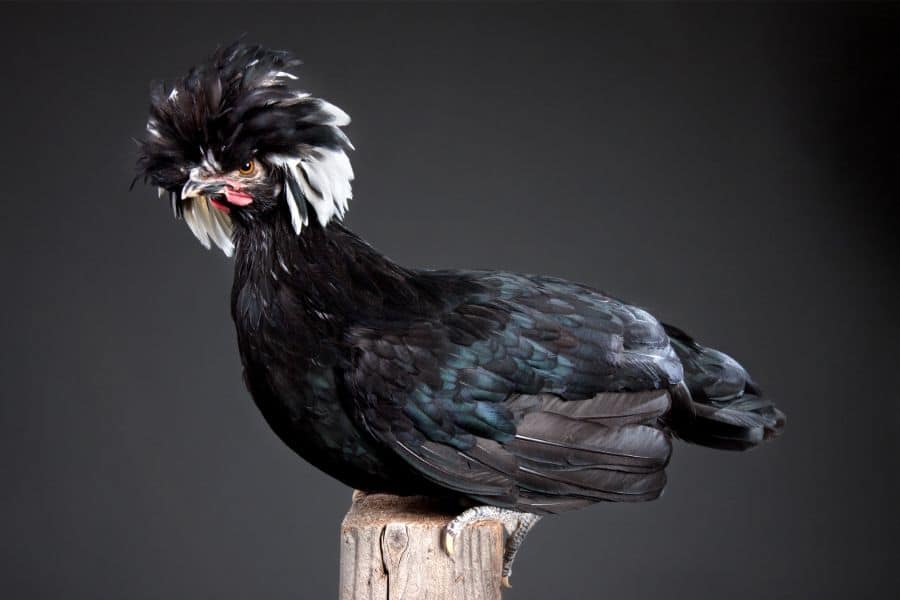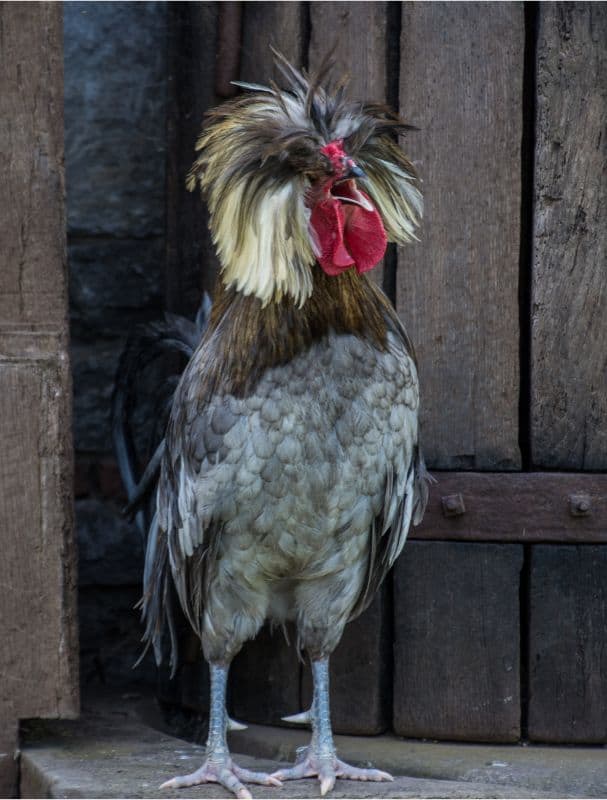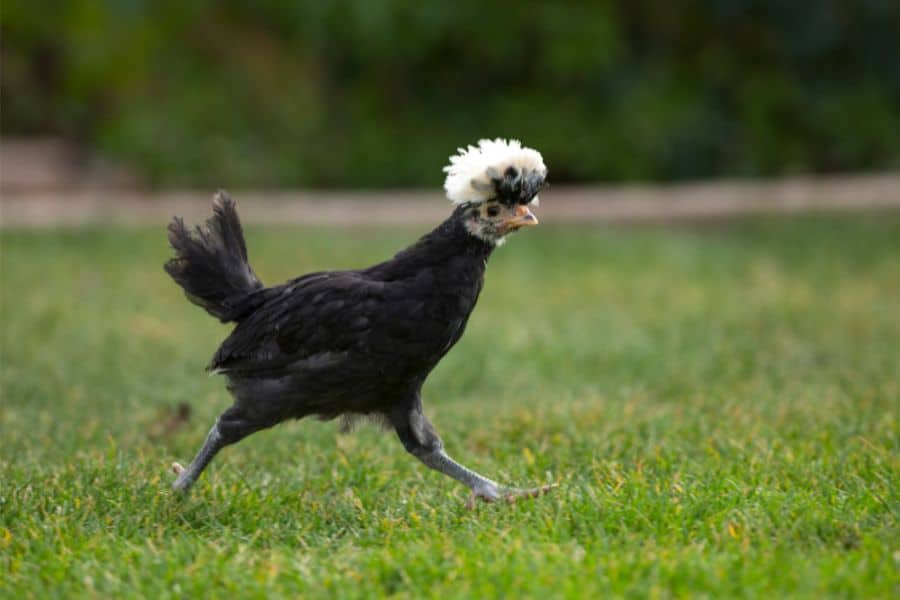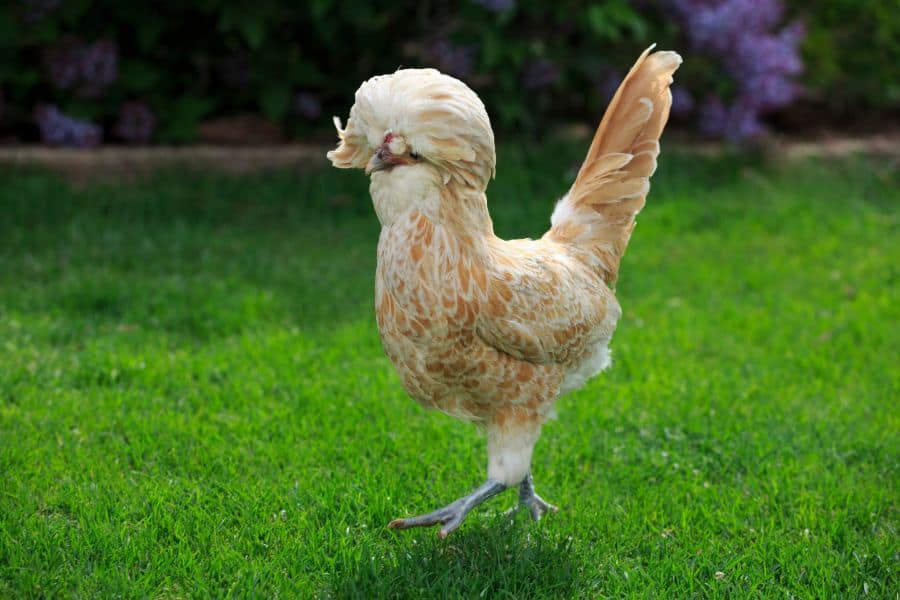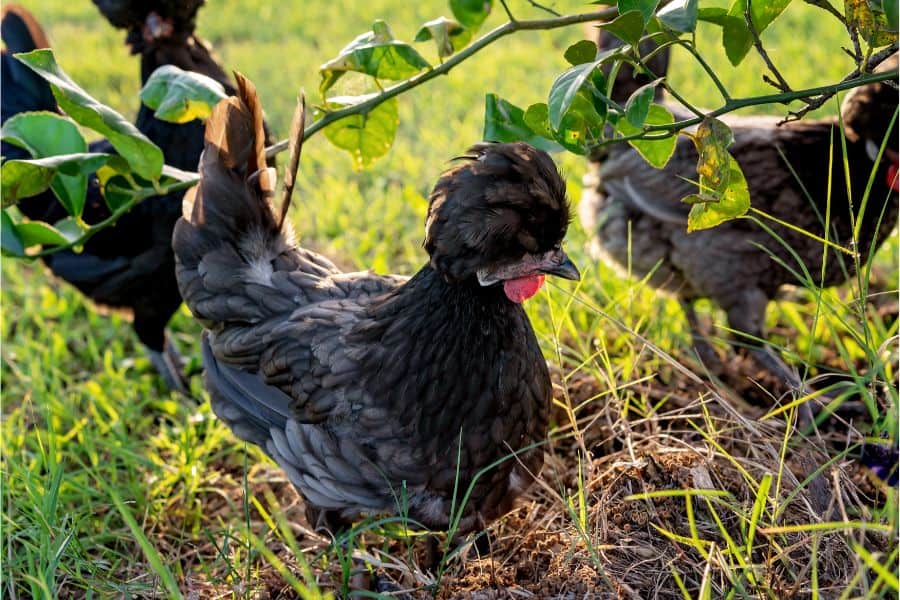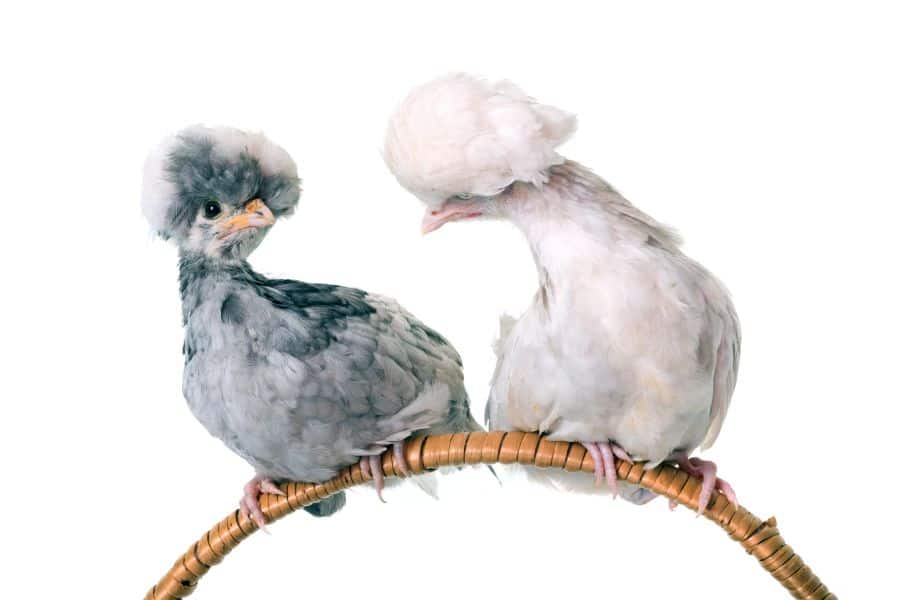Polish chickens are probably not the first breed most people will think about when they want to get into chicken farming. Surprisingly, these birds have a long and storied history and a look that makes them unforgettable as soon as you take one glance at them.
It’s not just the appearance of Polish chickens that catches people off guard, even their name might be a misnomer. It has never been established that these chickens were actually from Poland.
The utility of these birds around the farm has changed over the years, especially with the introduction of newer breeds that were significantly more productive. Luckily, their unique appearance meant that these chickens could still serve another purpose among enthusiasts.
If you’re looking for a new and unique chicken to add to your flock, Polish chickens may be the right fit. We take a look at the ancient origins of these birds, what it is like to live with them, what it takes to care for them, and why so many people find them endearing.
| Names | Polish, Poland, Tophat, Paduan |
| Origins | Europe (exact origins unknown) |
| Primary Purpose | Eggs and Exhibition |
| Egg Production | Mid |
| Climate | Warm Environments i.e., Not Cold Hardy |
| Personality | Easily startled |
| Weight | Roosters: 6 lbs.
Hens: 4.4 lbs. |
| Interesting Facts | Good flyers, will be found roosting on tree branches. |
The Long History of Polish Chicken
Origins
Nobody knows how far back the history of Polish chickens goes but it’s clear this breed has been around for more than half a millennium.
There are paintings from the 1400s done by artists from Italy and the Netherlands that feature these regal-looking birds. Polish chickens have also been mentioned in literature that date back to this period.
It has been speculated that the breeds that gave rise to Polish chicken may have been brought to Eastern and Central Europe in the Middle Ages (500 – 1400 CE). It’s also possible that this movement of the birds through Europe was facilitated by Mongols from Asia.
Some other historians believe that the origin of Polish chicken was in nearby Spain before they made their way to the Netherlands in the late 1500s.
The one fact that is not in doubt is that several key aspects of the modern-day Polish chicken were developed by the Dutch in the 1600s. These include the bird’s unmistakable crest and its refined color patterns.
The Name
At this point, you may be wondering why the history of a chicken breed called Polish includes no mention of Poland or anyone Polish. This is another source of confusion regarding this chicken breed.
It’s not possible to rule out the possibility that Polish Chicken originally came from Poland. On the other hand, the name ‘Polish Chicken’ may have come about because:
- The ‘Polish’ name was assigned by Charles Darwin because the chicken’s crest looked like Polish soldiers’ feathered caps.
- ‘Pol’ is a Dutch word that means ‘large head’.
Polish chickens have also gone by other names over the years including Paduan, Poland, and Tophat.
Appearance: Crests, Beards, and More
The first thing you’re likely to notice about Polish Chickens are their impressive crests. These birds look like they have an Afro hairdo or a pompom on their heads.
The crest on the heads of Polish Chickens is supported by a dome-shaped growth on their skulls, unlike anything you’d find on your regular backyard chicken.
The crests that many consider the most eye-catching feature of these birds can, unfortunately, be a problem since they can impede their vision in some cases. The roosters have a comb that is V-shaped and red, but you may fail to see it underneath all the feathers.
Other features you may notice about Polish Chicken include:
- White earlobes
- Very prominent nostrils
- Red wattles
- Gray legs with no feathers
There are bearded varieties of Polish Chicken, and these have a collection of feathers on their faces that resemble a beard. If the beard is large enough, it may hide the chicken’s wattles.
The frizzle gene is present in Polish Chicken but the characteristic frizzled feathers don’t show up on every bird. This is because the gene is said to be incompletely dominant.
When the effect of the frizzle gene shows up, the feathers of Polish chickens may not lie flat and instead curve outwards giving them a fluffy appearance. This may give the birds a uniqueness that is great for exhibition, but the frizzle gene can also cause feathers to be brittle or soft.
Also Read: Pretty Chicken Breeds
Why Keep Polish Chicken?
Egg-Laying
Back in the 18th Century, Polish Chickens in France and England were favored as layers. This is the reputation they brought with them when they were introduced to the United States in the early to mid-1830s.
Although Polish Chicken had become a common sight in both America and England in the 1850s, Leghorn chickens were also being introduced around this period.
Leghorn chickens can produce 300 eggs in a single year, and sometimes even more. It’s not possible to ascertain how productive Polish chicken layers were in the 1850s, but it was clear they could not compete with the Leghorns.
Polish hens can provide around 150 to 200 eggs in a single year. There are farmers who still keep Polish chicken today for the production of eggs but with the availability of more proficient layers, it’s obvious it’s not just about the eggs.
The eggs from Polish chicken can be medium or large. This is also the chicken to go for if you’re interested in getting white eggs.
If you’d like a hen that will lay eggs and also sit on them until they hatch, Polish chickens would not be a good choice. This breed is noted for hardly ever going broody.
Exhibition
Despite losing favor as layers, Polish chickens have persisted and this may be largely attributed to their appeal as show birds. The distinctiveness of the crest on these chickens makes them a favorite for those who keep chickens for ornamental purposes.
Keepers of show-quality Polish chicken invest a lot of time to get their chickens looking right for these shows. Scoring high points requires crests that are large and stand high, colors that are solid with the right sheen, lacing that is clear when present, and other features.
To ensure that the birds are ready for exhibition, the owners wash and clean them in the days leading up to a show.
Keeping a Polish chicken as a show bird is demanding because the bird will require more attention. Therefore, you should only make such a commitment if you’re ready to put in the work needed.
Meat
Polish chicken roosters weigh around 6 pounds when mature so in terms of quantity only, it doesn’t make much sense to keep these chickens for meat. It is also said that the quality of the meat makes it a poor meat bird.
Varieties of Polish Chicken
Like most chicken breeds, there are different variants of Polish chicken that have been accepted today. In 1874, four variants of Polish chicken were accepted as official breeds in the USA. These were the:
- White
- Golden
- Non-bearded white crested black
- Silver
Since then, six more varieties were added to the standard as follows:
- 1883: Bearded Buff Laced, Bearded Silver, Bearded Golden, Bearded White.
- 1938: The Non-Bearded Buff Laced
- 1963: The Non-Bearded White Crested Blue
Polish chickens have both a standard and a bantam variety. The bantam Polish chickens weigh around 850 grams when mature.
Thanks to the different colors of their plumage, it’s fairly easy to distinguish one variety of Polish chickens from another. Here is an overview of six of the above-mentioned color variants.
| Color-Variant | Characteristics | Chicks |
| Non-Bearded White Crested Black | · Black iridescent feathers
· White crest · Legs are gray with blue undertones |
· Face and chest have yellow down feathers.
· Backs have black down feathers. |
| Silver | · Silver feathers with black lacing
· Legs are gray with blue undertones |
· Feathers are different shades of gray.
· Knob at the top of the head. |
| Non-Bearded Buff Laced | · Feathers are golden with white lacing near the edges.
· Roosters tend to have darker plumage than hens. · Legs can be blue or gray with blue undertones. |
· Down feathers are yellow.
· Characteristic knob on their heads. |
| White Crested Blue | · Feathers can be Splash, black, or blue in color thus expect some color variety. | · Chicks have variety of colors as well including dark gray, light gray and black.
· Knob on the heads. |
| Golden | · Feathers on mature birds are a deeper brown compared to buff laced.
· Feathers have black lacing. · Legs are gray with blue undertones. |
· Have a knob on their heads.
· Down feathers are dark brown. · Golden down at the wingtips and around the eyes. |
| White | · Plumage is completely white in mature birds.
· Legs are gray with blue undertones |
· Yellowish-white down feathers. |
Personality and Temperament
Polish chickens are friendly and are well-suited to being kept as pets. They have also been described as curious.
However, this chicken breed is known to be excitable and can easily take flight if startled. Unfortunately, it doesn’t take much to startle Polish chicken.
The same crest that has attracted the attention of exhibitionists throughout the years comes with the disadvantage of obscuring the vision of Polish chickens. The limited visibility makes this breed prone to predation thus you may find yourself with a naturally nervous chicken.
It’s not unusual to hear the owners of these birds talking or even singing when approaching them as this lets the birds know early that they are approaching. If approached without warning, Polish chickens will quickly take off.
Polish chickens are good flyers compared to regular chicken breeds and it’s normal to find them sleeping or roosting on the branches of a tree. They can also fly up a tree if startled.
Caring For Polish Chicken
Environment
Polish chickens are not built to do well in cold environments because their beautiful crests collect water quite easily. In a cold environment, this water will freeze leading to the bird feeling cold and a cold chicken is not a happy chicken.
If you’re keeping Polish chickens, you must provide them with an environment that is warm and dry. They can handle warmer environments as long as there’s plenty of shade to go along with it.
A dry and well-ventilated coop is important for Polish chickens and they also need lots of space. In confined spaces, Polish chickens can resort to feather-picking which can result in damage to their crests.
Having a place where the chickens can perch during the day would also be great e.g. a tree. Be sure to put them back in their shelters at night to keep them safe as their crests make them an easy target for predators.
Diet
The energy needs of a Polish chicken will change depending on the season and they eat according to these requirements. It’s not unusual for these birds to eat more food during the winter months compared to summer since they need to produce more heat in their bodies.
There are different complete feed types you can buy for Polish chicken. These come in forms such as:
- Pellets
- Mash
- Crumbles
Ensure the birds’ feeders always have enough feed and you can also supplement this with grain. Additional nutrients like calcium help to improve the quality of eggshells and the growth of your chickens.
You’ll need to provide your chickens with hard grit. Chickens eat hard grit to help mechanically break down food in their gizzards.
Egg layers may need additional medications added to their feed to prevent conditions like coccidiosis. Chicken should also have a steady supply of clean water.
Grooming
Grooming is an important part of the regimen when taking care of Polish chicken that you use as show birds. The birds are typically bathed several days before a show, so they have plenty of time to dry.
It is best to use warm water when washing chickens along with a suitable shampoo and a conditioner. It is said that the birds get so relaxed during the bath they may even sleep.
You can use a blow dryer or towels to dry the chickens after the bath.
Trimming of the crest is recommended for show birds as well as regular Polish chickens. Although not always necessary, it can improve the quality of your bird’s life in a few ways.
The crests of Polish chickens can grow large enough to cover their eyes. An overgrown crest doesn’t just make it harder for them to spot predators, it can even make it difficult for them to find water and food.
Lifespan
You can expect your Polish chicken to be by your side for between 6 to 8 years if you’re keeping it as part of your backyard flock. The hens can lay eggs for 3 or 4 of these years but expect the quality and quantity of eggs to taper off with time.
Partners
A Polish chicken will not do well in every kind of flock. Their crests don’t just make these chickens a target for predators, other more aggressive chicken breeds may also start to pluck the feathers atop the heads of these birds.
A good way to find partners for a Polish chicken is to raise it together with the other chicks or to have a flock that is only made up of Polish chickens. Even in a flock made up of Polish chickens only, feather-picking can still be a problem if the birds don’t have enough space.
Also Read:
Is Polish the Way to Go?
The world of chickens has many breeds that may not seem any different from the next, but the Polish is certainly not one of them. The reason why these chickens have been included in paintings that date back centuries is that their presence commands an audience.
Polish chickens have a long and interesting history and rearing one today is an opportunity to be part of these chickens’ unique story.
These birds make great pets due to their friendly nature if they’re not scared. You can also get a Polish chicken if you’re thinking about getting into bird shows.
Polish chickens are not an ideal meat bird in any sense, but they are decent layers. These chickens will lay eggs for 3 or 4 years and can manage 150 to 200 eggs in one year which is a good return.
There are different types of Polish chickens for you to choose from whether you want a dark color or something brighter, and you can even get a bantam version.
Polish chickens do require a little more care especially if they’re kept for exhibition. Prepare yourself to do a little bit of washing and feather-trimming to keep your bird safe and looking its best.
